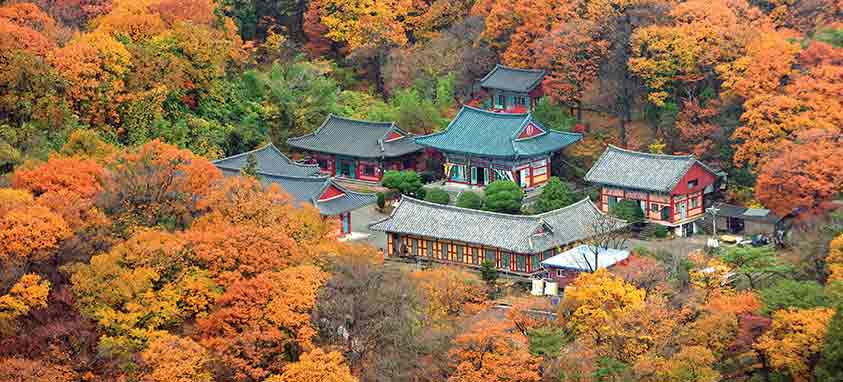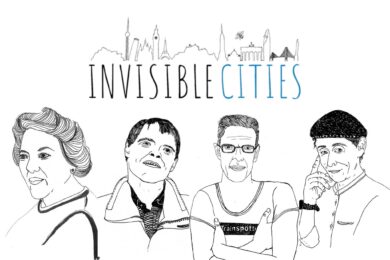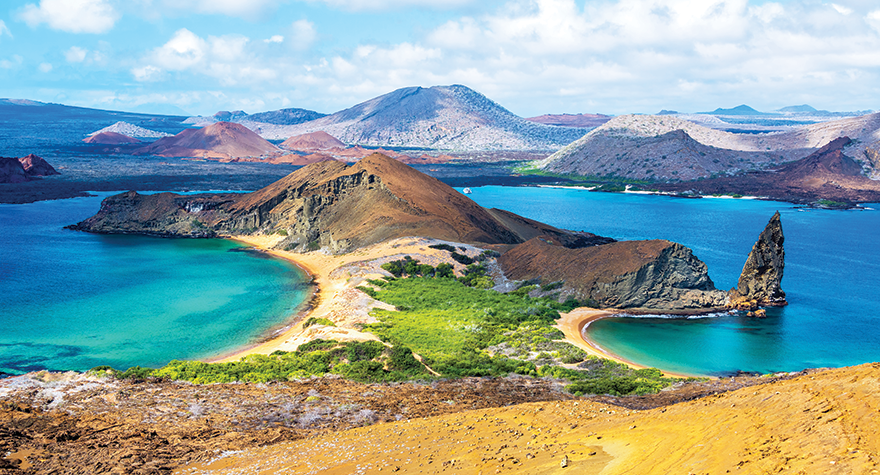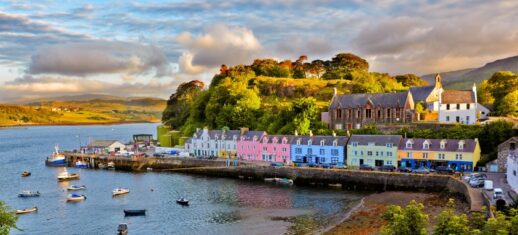Beomeosa Temple, Busan – Photos by Korea Tourism Organization
South Korea has become a very hot meetings destination
South Korea has a fascinating, rich heritage and is one of the most modernized countries in the world. This blending of the old and new makes it an intriguing destination, but it has been somewhat under the radar among meetings groups.
“As a destination, Korea has been a bit of a hidden gem, an undiscovered diamond in the rough, long waiting to shine for the meetings industry,” says Maureen O’Crowley, executive director of the Seoul Convention Bureau and Seoul Tourism Authority. “Therein lies the key: Korea is not a ‘been there, done that’ destination. It’s a surprising place that literally astonishes our visitors and leaves them questioning, ‘Who knew?’”
The rest of the world is steadily becoming aware of South Korea’s attractive features. The International Congress and Convention Association’s 2014 annual report showed that the Asian nation has the 17th most meetings of any country in the world, and Seoul ranks 15th among cities.
Seoul and Busan, South Korea’s two largest cities, are very different from each other in many ways. Seoul, in the northwest part of the country, is one of the world’s liveliest metropolitan centers and has a nonstop pace. Busan, on the other hand, is a somewhat laid-back, earthy city located in the opposite end of the country, in the southeast corner.
The cities are linked by their highly developed technology and full expression of South Korean culture, however, and offer groups many attractive choices, from luxury hotels to offbeat restaurants.
Seoul
 International Seoul Coex
International Seoul Coex
Seoul is the capital of South Korea and the world’s second largest metropolitan area, with more than 25.6 million people. The city proper has a population of 10 million and is home to more than half of all South Koreans, along with 678,102 international residents.
Situated on the Han River, Seoul is surrounded by mountains, the tallest being Mount Bukhan, the world’s most visited park per square foot. Seoul welcomed more than 10 million international visitors in 2014, making it the world’s 10th most visited city.
“Since the establishment of the Seoul Tourism Organization in 2008, we have worked hard to get the message out that Seoul is serious about the meetings industry, while also conveying the uniqueness of the capital as historic, trendy and fun,” O’Crowley says.
Top Hotels & Conference Centers: Seoul boasts many outstanding properties for lodging and meetings. Grand Hyatt Seoul, located in the heart of the city, provides 601 guest rooms and 36,042 sq. ft. of meeting space. InterContinental Seoul Coex—situated in Gangnam’s trendy district with easy access to shopping, leisure and business—offers 656 guest rooms and 26,446 sq. ft.
Four Seasons Hotel Seoul, a stylish new five-star hotel destination in Gwanghwamun, is scheduled to open this month. Combining Seoul’s fascinating blend of Old World tradition and new-wave cool, the property will offer 317 guest rooms and 23,638 sq. ft. of meeting space.
Coex (Convention and Exhibition Center), connected to Samseong subway station in the Gangnam-gu district, offers 1.95 million sq. ft. of space. The area around Coex is scheduled for a major expansion by 2020 that will bring 5.33 million sq. ft. of meeting space and lodging, shopping and entertainment.
Enticing F&B Options: Korean barbecue is famous worldwide, and one of the top spots for groups to sample it is Samwon Garden, situated near Apgujeong Station. The restaurant can accommodate 1,200 people and features a watermill, garden and ponds with tropical fish. The bulgogi (grilled, marinated beef) and other Korean dishes have been listed in the Michelin Green Guide South Korea. Samwon Garden has a main hall that seats 200 people, as well as smaller rooms.
Another famous Korean dish is samgyetang, created by stuffing a small chicken with rice, gingseng, garlic and other ingredients, and boiling it to make a smooth, nutritious soup. The dish is South Korea’s answer to chicken soup to help people who are sick or weary gain strength. One of the best places in Seoul to have samgyetang is Tosokchon restaurant, located near Gyeongbokgung Station.
Historic Temples: Changdeokgung Palace, a UNESCO World Heritage Site, is a can’t-miss historical attraction and one of Seoul’s prettiest palaces. The palace grounds were carefully built to blend with the existing landscape, resulting in a harmonious intertwining of natural beauty and traditional Korean architecture. Groups can explore the grounds and palace on their own or join a guided tour, and can participate in a separate tour of the Secret Garden—a stunning area in back of the palace that was the favorite of many royal families—by making advance reservations. The palace is near the Jongno and Anguk subway stations.
Considered the grandest of Seoul’s five palaces, Gyeongbokgung Palace served as the main administrative palace of the Joseon Dynasty. Gwanghwamun Gate is one of Seoul’s most recognizable images, and the grounds are steeped with history. The Changing of the Guards Ceremony in front of Gwanghwamun Gate is a popular attraction. The palace is located near the Gyeongbokgung Palace and Gwanghwamun stations.
Fun Outdoor Activities: Bike trials, walking paths and public exercise facilities are some of the outdoor activity options available along the Han River, which cuts through the city. In summer, public swimming pools and water-sports rentals are available. “You can even charter a private yacht, go on a cruise ride and rent a private boat in the warmer seasons to float on the river with friends and family,” O’Crowley says.
Busan
Busan is often overshadowed by Seoul, but has plenty to offer meeting groups.
A bustling city of approximately 3.6 million residents, Busan has a breathtaking coastline with scenic cliffs, mountains that provide excellent hiking and extraordinary views, and plenty of inviting hot springs.
“Busan has something for everyone, including famous beaches, mountains, temples, malls, hotels and convention facilities,” says Hyebeen Park, a MICE bureau staff member for the Busan Tourism Organization. “Busan’s MICE infrastructure is becoming known as among the best in the world.”
Top Hotels & Conference Centers: Busan Exhibition and Convention Center (BEXCO) is the city’s premier MICE and business destination. Situated in the heart of Busan’s Centum City convention district, BEXCO provides 515,504 sq. ft. of meeting space and a 4,002-seat auditorium.
Paradise Hotel Busan, a five-star establishment with a spectacular view of Haeundae Beach, offers 540 luxurious rooms and 17,846 sq. ft. of meeting space. Located in the center of the city, Lotte Hotel Busan overlooks the beautiful Port of Busan and features a duty-free store, movie theater, casino, 650 guest rooms and 48,243 sq. ft. of meeting space.
Enticing F&B Options: The Dongnae District is famous for pajeon, and Dongnae Halmae Pajeon is one of the best places to experience this classic Busan dish. The restaurant has preserved the unique taste of this speciality for four generations and has even been designated Busan Folk Restaurant No. 1.
Dongnae Pajeon, a sort of Korean pancake said to have been presented to a king long ago, is made from a combination of glutinous and non-glutinous rice flour, and contains seafood, beef and fresh green onions.
Yong Ggum is the strangest and hippest eatery in Busan. The name translates as “dragon dream,” but the restaurant is also known as The Cave Bar because it’s housed in an old World War II bomb shelter carved into the side of a hill. This makes for an unusual dining experience, amplified by the low lighting and drip-dripping of the cave water. Yong Ggum serves traditional Korean seafood and liquor, with their dongdongju, traditional Korean rice wine, coming highly recommended.
Historic Temples: Beomeosa Temple, Busan’s largest and most famous Buddhist temple, is more than 1,300 years old. Located at the edge of famous Mount Geumjeongsan, Beomeosa is one of the most delicate and luxurious structures of the Joseon Dynasty (1392–1910). The temple includes Iljumun, a three-story pagoda with four pillars, seven royal palace wings, pavilions, three gates and 11 hermitages. The temple is designated as a natural monument, and its surrounding Wisteria woods and valleys are most beautiful in May.
 Haedong Yonggungsa Temple, Busan
Haedong Yonggungsa Temple, Busan
Haedong Yonggungsa Temple, an oceanside structure in northeastern Busan, was built in 1376 by the great Buddhist teacher Naong. It contains a shrine, sanctuary, pagoda and sanctum. The main sanctuary was reconstructed in 1970 and offers great ocean views. The sanctuary can be reached by walking down a lantern-lined path with 108 steps.
“The best time to visit is April, when cherry blossoms are in full bloom,” Park says. “Also, in May thousands of lanterns are hung along the temple paths, creating a dazzling array of colors.”
Fun Outdoor Activities: Busan’s outdoor sports scene revolves around its many types of water activities. From April through October, the Nakdonggang River, Songjeong Beach, Dadaepo Beach and eight other places offer such sports as cruiser and dinghy yachting, windsurfing, rowing, canoeing, kite boarding, sea kayaking, rafting, surfing, and motor and banana boating.
Easy Access
Increasingly more meeting groups are being lured to Seoul and Busan by the many attractive options available. For U.S. citizens, another enticing feature is the ease of traveling there.
“Accessibility is a strong suit,” O’Crowley says. “There are nonstop flights from several U.S. gateways to Seoul, and U.S. citizens do not require a visa to enter. Korea is an ideal North Pacific hub with an appeal and ease of access that have tremendous pull within the region to boost attendance at international business events.”
Island Paradise
 Lotte Hotel Jeju
Lotte Hotel Jeju
A large island off the coast of the Korean Peninsula, Jeju Island is becoming an increasingly popular destination. In 2002, Jeju was designated as a free international city, allowing people from more than 180 countries to visit, and there now are 43 international flights to and from Jeju International Airport (CJU).
Jeju, South Korea’s premier resort destination, is known for its beauty, warm weather, interesting rock formations and unique local culture. There are plenty of things to do, from exploring picturesque beaches, waterfalls, cliffs and caves to experiencing scuba diving, paragliding, golfing, nightlife and casinos. Groups enjoy visiting Hallasan National Park, which surrounds a dormant volcano and is noted for its hiking trails and sightseeing.
Meeting groups have been taking notice of this picturesque island and its many attractive venues.
“Events can be any size, from small, one-day conferences for a local business to weeklong international conventions attracting world-renowned academics,” says Jinhun Cho, marketing director for Jeju Convention and Visitors Bureau. “Jeju’s accommodations often come with world-class conference facilities, so you do not have to leave your hotel grounds to get all you need from your business trip.”
Among the top resorts is Lotte Hotel Jeju, a luxury property in the heart of Jungmun Tourism Complex that features 500 guest rooms, nine restaurants and more than 35,138 sq. ft. of indoor and outdoor meeting space. The Shilla Jeju, also in Seogwipo, features outstanding views of the Pacific Ocean, world-class artwork, 429 guest rooms and 48,438 sq. ft.
International Convention Center Jeju (ICC JEJU), located in the Jungmun Tourist Complex, is a seven-story building with 83,398 sq. ft. of meeting space. Artfully blending tourist resources and convention facilities, this resort-style convention center is fully equipped for small to large international meetings.
Fun Facts
 –Seoul hosted the 1986 Asian Games and the 1988 Summer Olympics.
–Seoul hosted the 1986 Asian Games and the 1988 Summer Olympics.
–Free Wi-Fi access is available at more than 10,000 parks, streets and other public places in Seoul.
–Seoul is home to many international businesses, as well as Korean technology companies such as Samsung, LG and Hyundai.
–Busan boasts one of South Korea’s largest beach, Haeundae Beach (pictured), and longest river, Nakdonggang River.
–Busan is known as the baseball capital of South Korea. The city’s professional team is the Lotte Giants.
–Jagalchi Fish Market, the largest fish market in South Korea, is in Busan.




